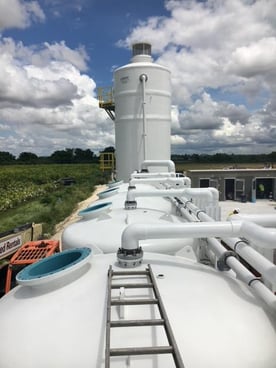
When operating a forced or induced draft water treatment tower system it is important to properly maintain your distribution system.
The distribution system is a fundamental component for any type of unit: an Aerator, Degasifier, Scrubber, or Air Stripper. It must be designed and constructed with precision and accuracy. This will ensure its optimal performance throughout its lifetime.
It is essential that the distribution system undergo regular and thorough maintenance. This will ensure it can do its job effectively.
Maintenance should include cleaning and inspecting pipes and connections. Additionally, worn or damaged parts should be replaced or repaired. Lastly, test the entire system to ensure proper functioning.
Regular maintenance is essential. It helps to prevent costly breakdowns or failures. Additionally, it minimizes disruptions to the distribution system.
Regular maintenance helps the distribution system run efficiently. This leads to better, more reliable service for customers.
The key role of the distribution system is to properly distribute the water flow over the media bed. If the distribution system is designed incorrectly then water will not be properly distributed which can cause multiple problems.
The distributor can be damaged or fouled. When this happens, the water pattern is changed. This affects the flow rate across the media bed. This can lead to low or high hydraulic flood conditions in the media bed.It is important to inspect the distribution system within 30 days of the initial startup of a system. Then decide, based upon application, if the future inspections can be extended to 90 or 180 days.
Iron oxidation and H2S require more frequent cleaning of the distribution system than a degasifier used for CO2 removal. This is because they are more corrosive.
Iron oxidation can cause quick damage to pipes, valves, and other components of the distribution system. H2S can corrode metal surfaces, resulting in deposits forming on the inside of the pipes. As such, regular cleaning of the system is necessary to prevent damage and maintain optimal performance.
CO2 does not corrode or build up deposits on the inside of the degasifier. This is an important factor in how long the equipment lasts. Iron Oxidation, a type of corrosion, happens when oxygen molecules interact with the iron in the degasifier. This causes the metal to corrode, leading to rust formation.
Rust can clog the system, decreasing its efficiency. In some cases, regular cleaning and maintenance is required. CO2 does not cause corrosion. Therefore, the degasifier will not require frequent cleaning and maintenance.
Heavy Hydrogen Sulfide (H2S) is a gas with a strong, unpleasant odor. It is highly corrosive and can cause severe damage to pipes and other structures. When present in the water distribution system, H2S can react with the metal pipes, leading to corrosion and leakage. This can lead to water contamination and other issues.
These issues include an increased risk of pipe bursts. This can put the safety of the public at risk.
In order to prevent this, it is important to regularly clean the distribution system and remove any built-up H2S. Cleaning should involve the right cleaning agent, like chlorine or hydrogen peroxide. Proper techniques should also be used to guarantee the removal of all H2S from the system. Proper maintenance of the system is essential to ensure the safety of the public and the longevity of the infrastructure.
A degasifier is a device used to remove Carbon Dioxide (CO2) from a liquid, such as water. By removing the Carbon Dioxide, the water is made less corrosive and therefore less likely to cause damage to the pipes. As such, the degasifier does not require as frequent cleaning as the system used for removing Iron and Hydrogen Sulfide.
To ensure top performance, keep the distribution system clean and working properly. Regardless, of whether you have a tray distribution system or a nozzle system. Fouling or damage can occur during normal operation at any time. For more information or to learn more contact the professionals at DeLoach Industries Inc. at (941) 371-4995.
Related Blog: How to Troubleshoot Your Blower




